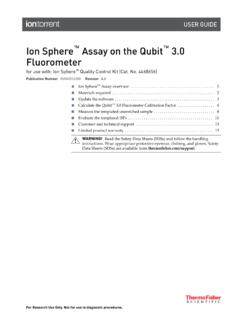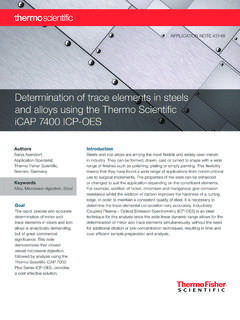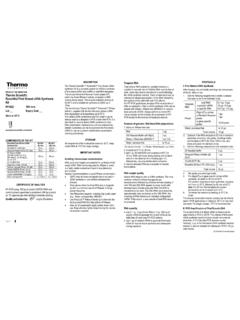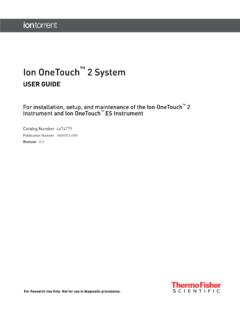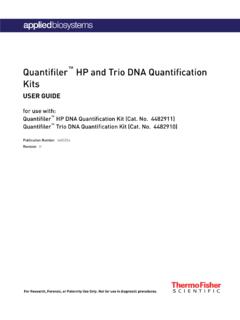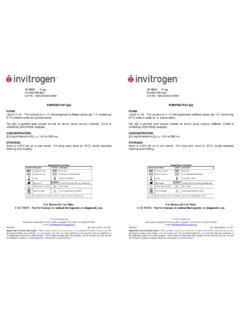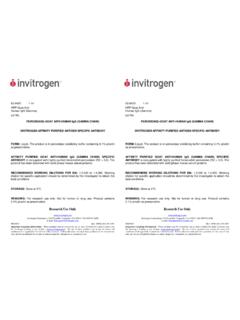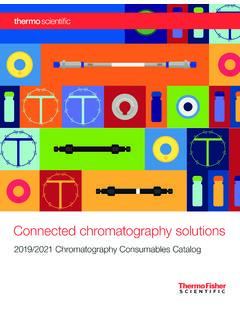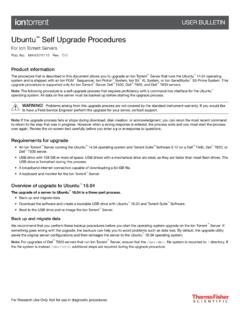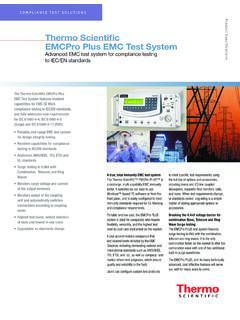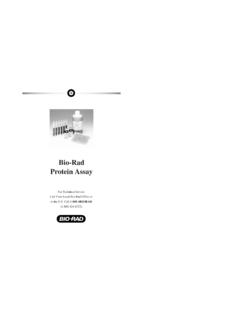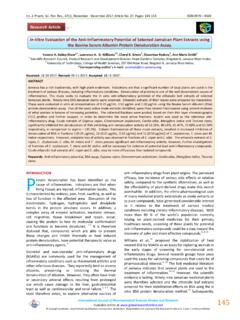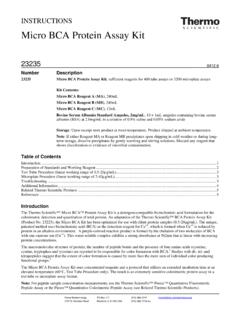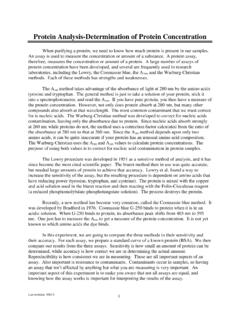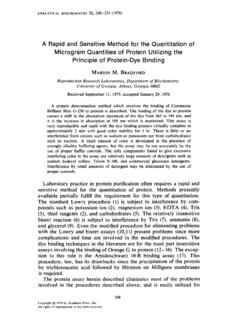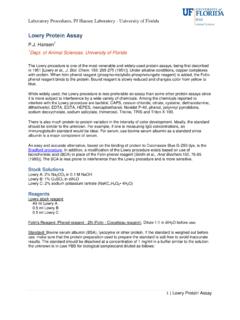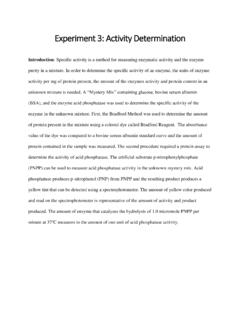Transcription of PierceA Protein Assay Kit BC - Thermo Fisher Scientific
1 Pierce BCA Protein Assay KitCatalog Numbers 23225 and 23227 Doc. Part No. 2161296 Pub. No. MAN0011430 Rev. ! Read the Safety Data Sheets (SDSs) and follow the handling instructions. Wear appropriate protective eyewear, clothing, andgloves. Safety Data Sheets (SDSs) are available from Thermo Scientific Pierce BCA Protein Assay Kit is a detergent-compatible formulation based on bicinchoninic acid (BCA) for the colorimetricdetection and quantitation of total Protein . This method combines the well-known reduction of Cu+2 to Cu+1 by Protein in an alkaline medium (thebiuret reaction) with the highly sensitive and selective colorimetric detection of the cuprous cation (Cu+1) using a unique reagent containingbicinchoninic acid (see reference 1 on page 4).
2 The purple-colored reaction product of this Assay is formed by the chelation of two molecules ofBCA with one cuprous ion. This water-soluble complex exhibits a strong absorbance at 562 nm that is nearly linear with increasing proteinconcentrations over a broad working range (20 2000 g/mL). The BCA method is not a true end-point method; that is, the final color continues todevelop. However, following incubation, the rate of continued color development is sufficiently slow to allow large numbers of samples to beassayed macromolecular structure of Protein , the number of peptide bonds and the presence of four particular amino acids (cysteine, cystine,tryptophan and tyrosine) are reported to be responsible for color formation with BCA (see reference 2 on page 4).
3 Studies with di-, tri- andtetrapeptides suggest that the extent of color formation caused by more than the mere sum of individual color-producing functional groups (seereference 2 on page 4). Accordingly, Protein concentrations generally are determined and reported with reference to standards of a commonprotein such as bovine serum albumin (BSA). A series of dilutions of known concentration are prepared from the Protein and assayed alongside theunknowns before the concentration of each unknown is determined based on the standard curve. If precise quantitation of an unknown Protein isrequired, it is advisable to select a Protein standard that is similar in quality to the unknown; for example, a bovine gamma globulin (BGG)standard (see Related products on page 3) may be used when assaying immunoglobulin Assay procedures are presented.
4 Of these, the Test Tube Procedure requires a larger volume ( mL) of Protein sample; however, because ituses a sample to working reagent ratio of 1:20 (v/v), the effect of interfering substances is minimized. The Microplate Procedure affords the samplehandling ease of a microplate and requires a smaller volume (10 25 L) of Protein sample; however, because the sample to working reagent ratio is1:8 (v/v), it offers less flexibility in overcoming interfering substance concentrations and obtaining low levels of : For peptide sample concentration measurements, use the Thermo Scientific Pierce Quantitative Fluorometric Peptide Assay or the Pierce Quantitative Colorimetric Peptide Assay Kit (see Related Thermo Scientific Products).
5 Preparation of standards and working reagent (required for both Assay procedures)Preparation of diluted albumin (BSA) standardsDilute the contents of one albumin Standard (BSA) ampule into several clean vials, preferably using the same diluent as the the following table as a guide to prepare a set of Protein standards. Each 1 mL ampule of 2 mg/mL albumin Standard is sufficient to prepare aset of diluted standards for either working range suggested in the table. There will be sufficient volume for three replications of each 1 Preparation of diluted albumin (BSA) standardsDilution Scheme for Standard Test Tube Protocol and Microplate Procedure (Working Range = 20 2,000 g/mL)VialVolume of Diluent ( L)Volume and Source of BSA ( L)Final BSA Concentration ( g/mL)
6 A0300 of Stock2000B125375 of Stock1500C325325 of Stock1000D175175 of vial B dilution750E325325 of vial C dilution500F325325 of vial E dilution250G325325 of vial F dilution125H400100 of vial G dilution25I40000 = BlankDilution Scheme for Enhanced Test Tube Protocol (Working Range = 5 250 g/mL)VialVolume of Diluent ( L)Volume and Source of BSA ( L)Final BSA Concentration ( g/mL)A700100 of Stock250B400400 of vial A dilution125C450300 of vial B dilution50D400400 of vial C dilution25E400100 of vial D dilution5F40000 = BlankUSER GUIDEFor Research Use Only. Not for use in diagnostic January 2020 Preparation of the BCA working reagent (WR) the following formula to determine the total volume of WR required:(# standards + # unknowns) (# replicates) (volume of WR per sample) = total volume WR requiredExample: for the standard test-tube procedure with 3 unknowns and 2 replicates of each sample:(9 standards + 3 unknowns) (2 replicates) (2 mL) = 48 mL WR requiredNote.
7 ML of the WR is required for each sample in the test-tube procedure, while only 200 l of WR reagent is required for each sample inthe microplate WR by mixing 50 parts of BCA Reagent A with 1 part of BCA Reagent B (50:1, Reagent A:B). For the above example, combine 50 mL ofReagent A with 1mL of Reagent : When Reagent B is first added to Reagent A, turbidity is observed that quickly disappears upon mixing to yield a clear, green sufficient volume of WR based on the number of samples to be assayed. The WR is stable for several days when stored in a closedcontainer at room temperature (RT).
8 Procedure summary (test-tube procedure, standard protocol)Test-tube procedure (sample to WR ratio = 1:20) mL of each standard and unknown sample replicate into an appropriately labeled test mL of the WR to each tube and mix and incubate tubes at selected temperature and time: Standard Protocol: 37 C for 30 minutes (working range = 20 2000 g/mL) RT Protocol: RT for 2 hours (working range = 20 2000 g/mL) Enhanced Protocol: 60 C for 30 minutes (working range = 5 250 g/mL)Note: Increasing the incubation time or temperature increases the net 562 nm absorbance for each test and decreases both the minimum detectionlevel of the reagent and the working range of the protocol.
9 Use a water bath to heat tubes for either Standard (37 C incubation) or Enhanced (60 C incubation) Protocol. Using a forced-air incubatorcan introduce significant error in color development because of uneven heat all tubes to the spectrophotometer set to 562 nm, zero the instrument on a cuvette filled only with water, then measure the absorbance of all thesamples within 10 : Because the BCA Assay does not reach a true end point, color development will continue even after cooling to RT. However, because therate of color development is low at RT, no significant error will be introduced if the 562 nm absorbance measurements of all tubes are madewithin 10 minutes of each the average 562 nm absorbance measurement of the Blank standard replicates from the 562nm absorbance measurement of all otherindividual standard and unknown sample a standard curve by plotting the average Blank-corrected 562 nm measurement for each BSA standard vs.
10 Its concentration in the standard curve to determine the Protein concentration of each unknown procedure (sample to WR ratio = 1:8) 25 L of each standard or unknown sample replicate into a microplate well (working range = 20 2000 g/mL). (For example,ThermoScientific Pierce 96 Well Plates, Product No. 15041).Note: If sample size is limited, 10 L of each unknown sample and standard can be used (sample to WR ratio = 1:20). However, the workingrange of the Assay in this case is be limited to 125 2000 200 L of the WR to each well and mix plate thoroughly on a plate shaker for 30 plate and incubate at 37 C for 30 plate to RT.
